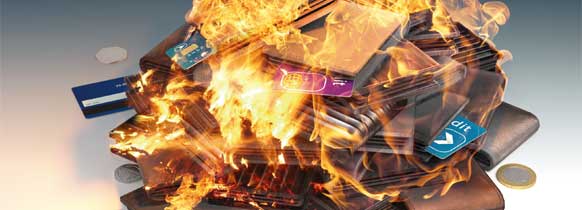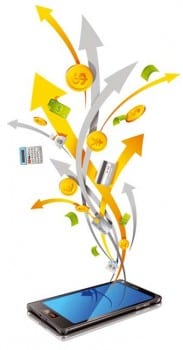Burning a hole in the pocket
In a world where it’s almost too easy to part with your digital currency, innovation has moved on to the contents of the digital wallet.
April 26, 2012

Solvency aside, it is not difficult for the mature market consumer to pay for goods and services. Cash, cheque, credit and debit card, gift vouchers, loyalty schemes, bank transfer, online payment—there are numerous routes to the exchange of value. Factor in the mobile phone and the options continue to stack up; Premium SMS (PSMS), NFC, carrier billing and the use of the mobile as just another internet terminal. Payment—mobile or otherwise—can be done.
The transaction in itself is no longer the central theme of the mobile financial services (MFS) story, partly because the problem has been solved (if not to the exclusion of further innovation) and partly because the various stakeholders in the MFS sector have wider agendas. Retailers, for example, are more interested in driving footfall to their stores than they are in improving the transaction process. Banks are looking to the mobile channel to drive product sales and cut the cost of customer interaction as well as for alternative and increased transaction revenues. Both are keen to see the back of cash.
For mobile operators the transaction is less central because deriving revenue from it is, for them, extremely challenging. Interchange fees on electronic payments are wafer-thin, with payment schemes, issuing banks and merchant acquirers among the players already taking their cut. With so little per-transaction revenue on offer, existing beneficiaries are highly protective of their shares. “If we’d gone to the banks three years ago and said we were going after interchange, every door would have closed on us,” says Claire Maslen, senior market development manager and programme manager for NFC at O2.
For these and other reasons, the mobile wallet is now emerging as the key point of competition within the MFS space. In conference presentations, speakers wishing to illustrate the concept are fond of including a picture of their physical wallet, unpacked. Invariably it contains some cash (maybe in a number of currencies), credit and debit cards from a variety of financial service providers, a driving licence, perhaps a contactless public transit card and one or two crumpled loyalty coupons and supermarket points vouchers.
The end game for proponents of the mobile wallet is that this cumbersome collection of physical tokens be dematerialised, digitised and deployable individually and when required from the smartphone—wherever the user might be. While it seems highly unlikely that many governments will allow drivers’ licences to be absorbed into a mobile wallet in the medium term, for the remainder of the standard wallet contents there is no conceptual obstacle.
But there are more questions associated with the mobile wallet than answers. Is all that is required to provision the service a downloadable app, for example? Should essential data be native or in the cloud? Should the SIM, the hardware or the OS house key informational and security components? While opinions vary, the target destination is common across the sector.
Every destination requires a journey, though. And, as with most journeys, this one has a number of milestones that must be passed, more than one potential route and ample opportunity for delays, accidents and wrong turns.
Leadership and navigation are key. Financial services providers see anything to do with consumers’ money as their natural environment, and MNOs take a similar approach whenever ‘mobile’ is used as a prefix. The truth is that no one type of player in the space is better placed because of their existing business to be the supplier-manager of the mobile wallet than any other. But MNOs in many markets have identified it as territory they need to occupy, and are mobilising accordingly.
They have some factors in their favour. In most instances they remain the route by which consumers acquire the handset itself. They are expert in provisioning services at scale. They have the ability to remotely kill a handset should it go missing along with the contents of its mobile wallet. Collectively they have existing financial relationships with almost the entire target market.
Then there is their oft-cited ability to provide an added layer of context. The location and marketing services that some operators are now developing could be used to make the wallet more intelligent and useful to the consumer, and more potentially rewarding for retailers, they say.
Not that these assets are exclusive. In the Philippines, Citibank recently launched a banking app for Android, iOS and Blackberry that includes the capability to redeem rewards points and promotional offers from Citibank on food and shopping.
And in the UK, the Payments Council, established in 2007 to “ ensure that UK payment systems and services meet the need
of payment service providers, users and the wider economy,” is building a database linking bank accounts to mobile phone numbers. The organisation’s aim is to enable P2P mobile payments, and the database will be made available to all UK banks and building societies before the end of 2012. Crucially, the service will enable banks to remotely disable an account.
These are just two examples which illustrate the fact that none of the individual facets that support the MNOs’ bid to lead the mobile wallet charge are impossible to replicate. But the operators argue that, collectively, these assets make a convincing argument for their leadership.
Of course that argument can be challenged. The success of Apple, Google and Android in creating consumer demand and loyalty has shaken the operators’ concept of customer ownership. And the way these players have harnessed a global pool of creativity to innovate in the service layer has at times made the operators look pedestrian and out of touch.

payment-tall
Perhaps because of the range of players with both a stake in the m-wallet and the potential to contend with operators for leadership, the MNOs are combining for strength. In Sweden there is 4T, the JV created by Hi3G, Tele2, Telia and Telenor, partners that also plan to join forces in Norway and Denmark. In the UK, Everything Everywhere, Vodafone and O2 have submitted a proposal to the EC for the creation of Oscar, a mobile advertising and commerce JV, while Mpass is a comparable venture between the same players (less Orange) in Germany.
Japanese operators NTT DoCoMo, KDDI and Softbank established the Japan Mobile NFC consortium last year in a bid to provide harmony between the existing and popular mobile wallet service in their domestic market and other offerings being developed internationally. In the US, AT&T, Verizon and T-Mobile’s NFC-enabled mobile wallet service, Isis, is due for commercial launch in the summer of this year.
Banding together is essential for operators in the m-wallet space because it allows them to claim reach across a far larger share of the target market than any other player. It also ensures freedom of movement for the consumer. Handset and OS vendors are just as keen as operators to generate stickiness but if the mobile wallet is to truly replicate the physical wallet, it must be portable between the systems being used to carry it. Wallets, after all, are designed to fit in the pockets of most trousers and jackets.
A user will not want to have to remain with Android, Windows Phone or Apple simply because their payment mechanisms are tied to one or other platform. They would equally resent being bound to a mobile operator for the same reason. If the mobile wallet is provided by a joint venture, or if a background collaboration ensures ease of portability, this problem is solved. While operators in many markets were notoriously inert when it came to implementing mobile number portability, there is no such dragging of heels with the mobile wallet initiatives.
In some instances, operators will look to make their own branded wallet offering portable, so that consumers who churn to another network might remain as a customer of that operator’s mobile wallet. In the UK, while the functions of the mobile wallet might be common, if and when the JV is approved, operators will compete on the service level. For the foreseeable future each operator will maintain its own m-wallet database in the hope that consumers will simply download that wallet over their new network if and when they churn.
In other markets, the US and Sweden, for example, the wallet is operated, provided and stored by the JV, with a central database of account details so that users can simply fire up their wallet every time they get a new handset, or shift to a new operator. In the Isis model, according to Jaymee Johnson, the group’s head of marketing, the only difference between the wallet when accessed from the different operators’ handsets, is a brief operator logo in the boot up stage.
But for all the importance of collaboration, there are some rather obvious omissions. In the UK, Hutchison’s 3—by far the smallest of the five operator brands in the market—has had no part in the creation of the Oscar concept, or the submission to the EC. Sprint Nextel, meanwhile, is not a part of Isis at launch, despite being a significantly larger operation than T-Mobile.
There is no doubt that, privately, the exclusions smart. Publicly, Isis is keen to extend partnership opportunities to all other operators, says Johnson, although it is less clear whether there are opportunities for the likes of Sprint and Metro PCS to take equity stakes in the company. “Isis is open to any other carriers, any banks, any payment networks,” he says. “In terms of equity, we do happen to be owned by three carriers, but that is a separate issue form the operating service we provide to them. Additional operators would get the same set of services that we provide to the original three founders.”
In Sweden, Johan Ragnevad, acting managing director at 4T says his JV was founded on the belief that all operators had to be equal partners from the outset. “All the operators in Sweden have been playing around with ideas and they have actually made several attempts [at mobile wallet services] over the last three years,” he says. “Then a little over a year ago all four network operators realised that, if this was going to fly, everyone needed to be in on it.”
What everyone does not need to be in on, according to Ragnevad, is SIM-based NFC as the authentication and connectivity paradigm. SIM-based NFC has the backing of GSMA, which arguably speaks for the largest international operators and wields significant influence over the smaller ones. Nav Bains, business lead for mobile NFC services at GSMA, sets out the organisation’s position: “What [some] operators are doing is providing a common platform—the SIM-based NFC phone—which is secure, complies to international standards, is portable and interoperable. Operators are collaborating to allow any consumer in that market to go to any carrier and use any handset and any operating system.”
The problem with NFC, however, is that there are huge question marks over timelines and penetration of both consumer and merchant devices. David Hodgkinson, a financial services specialist at KPMG, says the firm believes that the hype around NFC is “unprecedented”, and suggests that mass adoption could still be five years away.
Johan Ragnevad says that, while 4T and its owners “believe strongly in NFC, using the SIM card,” they are “very realistic in terms of the time it will take to get into phones and to get those phones into the market. And at the other end it will take time to get the readers into merchant premises.”
He continues: “That is why we say to the Swedish market, with some disappointment, that this will take another two to three years.”
In the US, the Isis project, by contrast, is all about NFC. The group has announced handset support from six handset vendors, although Apple and Nokia are not on board. The Isis app does have an iOS incarnation, but it is operated through an NFC-enabled cover that fits over the phone. What Isis has not yet communicated, however, is which devices will be available to launch the mobile wallet when it launches in its first two markets—Salt Lake City, Utah and Austin, Texas—later this year.
The firm’s efforts have been more recently focused on alignment at the retail end. Isis has enlisted the four largest point of sale terminal manufacturers in the US, all of which are now including support for the Isis application in their terminals at the point of manufacture. While refreshment cycles for PoS terminals vary depending on the retailer, Isis’ Jaymee Johnson argues that upgrading is, for merchants, “a relatively trivial investment”.
Just as Isis’ technology strategy is in line with GSMA’s position, so is its business model. Nav Bains again: “The business model that GSMA advocates is one of SIM rental. An NFC SIM card can be partitioned into several secure domains, and the operators can charge a fee to each financial service provider to have their app running in the SIM card. The MNOs don’t take a single penny out of the transaction itself, which is a big relief for the bank.”
This is exactly the model that Isis has adopted. “The banks,” says Jaymee Johnson “are our customers.” There will be three financial service providers onboard at launch, Chase, Capital One and Barclaycard and the Isis mobile wallet will serve “as an extension of the existing cardholder relationship,” Johnson says. A second revenue stream will see Isis offering the wallet as a marketing channel for retailers, “much more like a direct response advertising model.”
This is a model carefully crafted to keep the banks onside, and deter them from moving into the affiliate marketing model that many operators are now looking to exploit. But not all players are going about things in quite such a sensitive way.
In Sweden, while 4T will offer consumers the ability to attach their mobile wallet to an existing bank, it will also be offering a credit facility that will see users billed on a monthly basis for anything they buy using their WyWallet (the 4T consumer brand). This credit fee is one revenue stream. Another will be a commission from merchants on payments made over the mobile wallet.
“We will give customers the choice to use their phone as an extension of their bank account,” says Johan Ragnevad. “But we are not blind, we see there is a substitution or conflict situation coming up. And I am really positive about our ability to affect the ecosystem and make payments more cost-effective.”
Because no element of the 4T service will sit on the SIM card, a range of payment options will be available. In Sweden PSMS has very high penetration, so this payment method will be central to the service. Standard internet payment scenarios will also be supported and a merchant offering will be available during the next year (the service is set to launch in June), says Ragnevad, although on which technology it is not yet clear.
“One idea is to have NFC stickers on the devices, another is to look at different QR code processing,” Ragnevad says. “Premium SMS could offer more for merchants, as well. There are optical readers on the way that are quite cheap that can read an SMS and verify authenticity,” he says. The 4T service will launch before a decision on an interim solution for retailers has been made.
The only service that 4T will offer that will carry a per transaction charge is peer to peer payment. This is not something that will be part of the Isis offering, but is essential in Sweden, Ragnevad says. For each transaction there will be a charge of one Swedish Krona, around e0.11.
In the UK, O2’s Claire Maslen says she believes there will be a three-phased approach to the mobile wallet. “The first phase will be pre-NFC, using a stored value account from which users can spend online, or person to person. The next will see that stored value account linked to NFC and being used for low value transactions in the high street,” she says. “But ultimately the end game is that we completely replace the wallet, do away with the stored value account and link directly to the user’s bank account.”
O2 plans to derive the vast majority of its m-wallet revenues from marketing solutions. “It’s not about transactions for us, it’s about closing the transaction loop,” she says. “It’s about being able to deliver a targeted campaign to consumers that drives footfall into the retailer and encourages them to redeem a voucher or coupon and make a payment. We can collect all that data and start to target users more effectively. Marketing is a really strong piece of it.”
This contrasts directly with the Isis approach, as the US JV will have no visibility of where its customers are spending their mobile money, or what products they are buying.
O2 will also levy a charge on users who seek to convert money stored in their mobile wallet into cash, something that Maslen says is “the same as what it costs us; it’s not a margin generator. It’s designed to keep consumers spending their money elsewhere in the ecosystem.” There are regulatory limits on what amounts of money users will be able to spend from their mobile wallets, depending on what means of transfer is used, and how much information the operator has on the customer.
When NFC comes online they will be restricted to transactions below £15. Maslen suggests that users will be comfortable spending up to the “low hundreds” from their pre-NFC stored value mobile wallet.
The use of stored value accounts is interesting from a usability perspective. O2 is using it as a means of getting to market before the ideal solution will be ready. Isis will be offering its own-branded stored value account for two reasons; first because only three banks are partnering at launch, and it enables the company to hit a wider market and second because it can be preloaded with value to encourage users to try the service.
But having to move money into a separate account just so you can spend it in a new way sounds to some like a discouragement to the behaviour that is being sought. “This is the point about hype,” says KPMG’s David Hodgkinson: “We just assume people will want to do these things because we’ve built it and we’re excited about it. Stored value is really not that attractive. Why do I want to start putting money on a prepaid debit card? It’s a real barrier to adoption.”
This poses the wider question of whether mobile wallets are fundamentally appealing to end users. Hodgkinson cites a recent YouGov survey of UK consumers that revealed only 23 per cent showing an interest in mobile payment, and only ten per cent showing likelihood of using such services in the future. Rather than flocking to the services when launched, he argues consumers will have to be enticed onto the service through giveaways.
Others disagree. Nokia’s Gerhard Romen says that the NFC-enabled mobile wallet will tap into the human enthusiasm for touching and pointing at things that we want. Jaymee Johnson says that, at the end of the Isis user trials they had difficulty getting consumers to return the handsets.
The concern is that the mobile wallet becomes over complicated as operators and financial service providers look to manage a wealth of technology- and business models. Everyone agrees on the risk posed by other players, chief among them Apple. With more than 200 million financial data sets through its iTunes service, Apple’s appearance in this space is a matter of when, not if. NFC is on the firm’s roadmap and it has a knack for putting simplicity at the heart of its products and services. This is not necessarily something at which the banks and mobile operators can claim to excel.
Read more about:
DiscussionAbout the Author(s)
You May Also Like











_1.jpg?width=300&auto=webp&quality=80&disable=upscale)


.png?width=800&auto=webp&quality=80&disable=upscale)